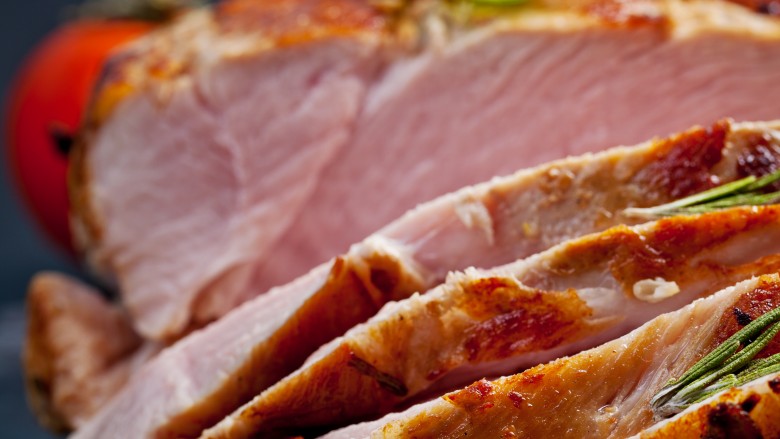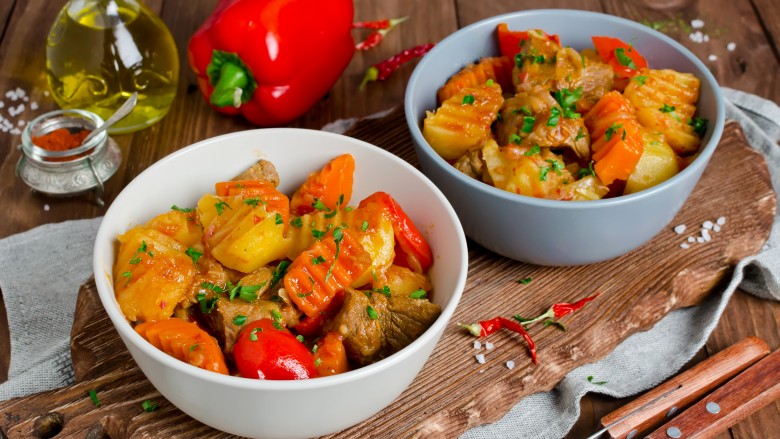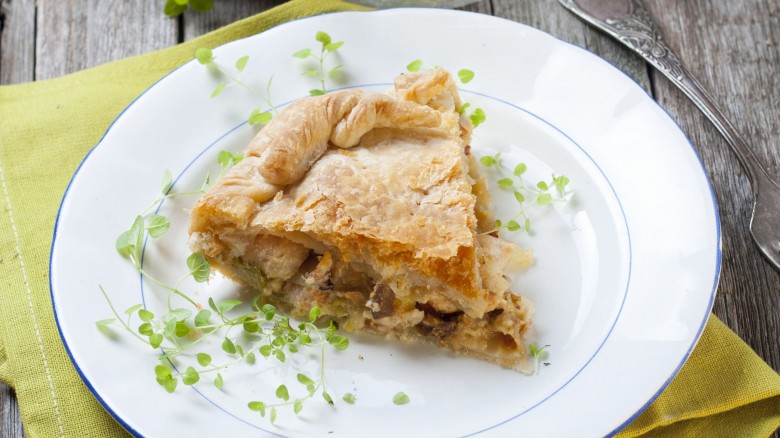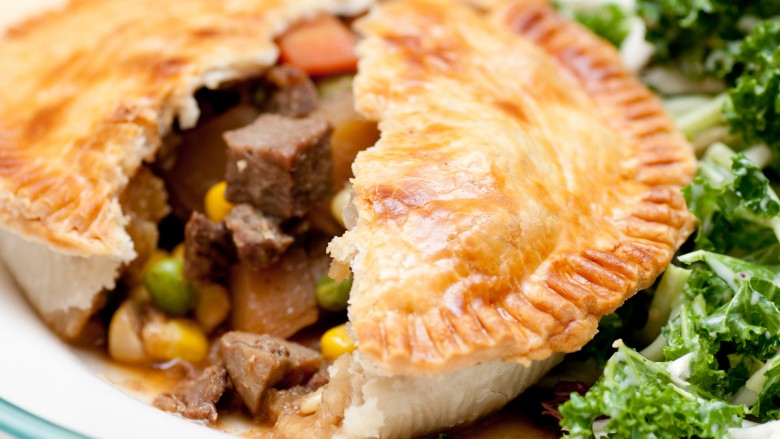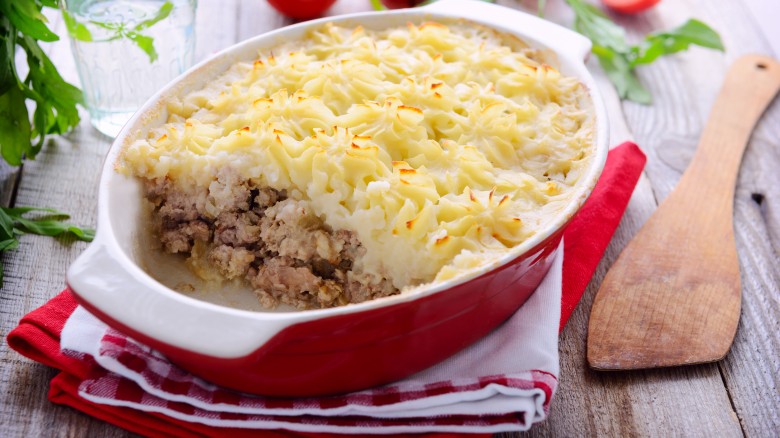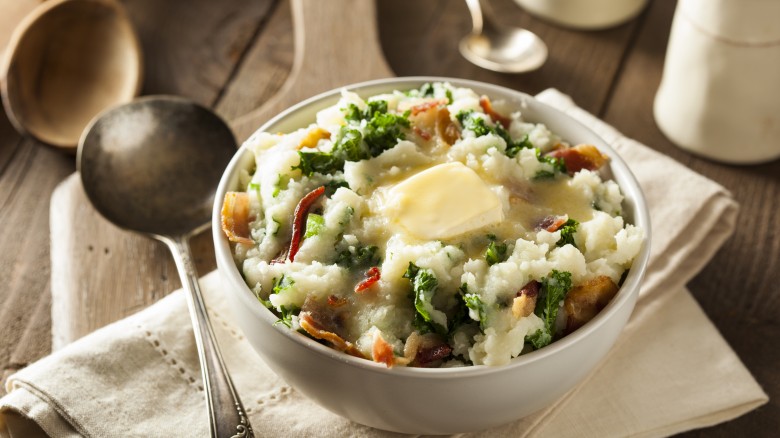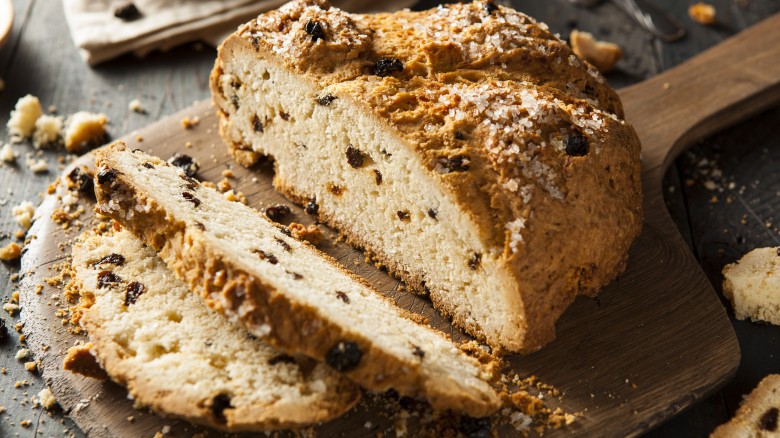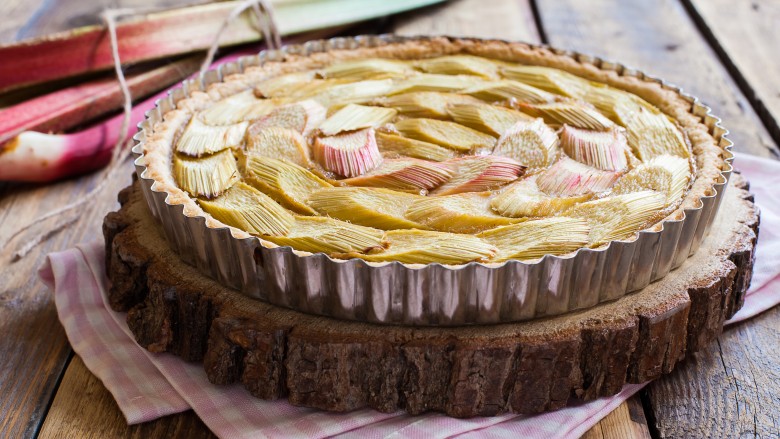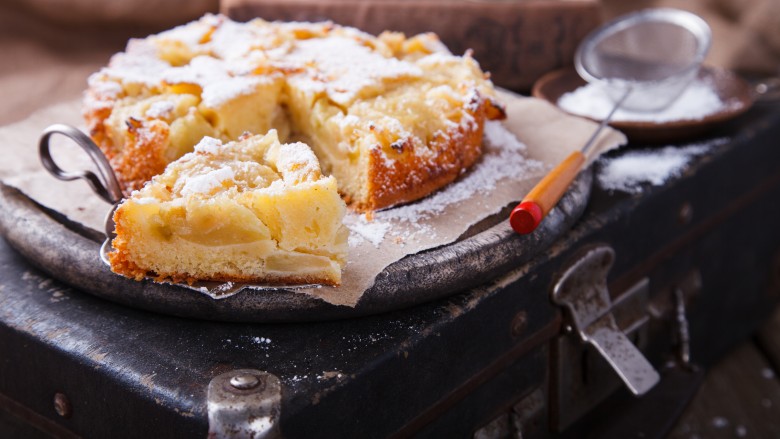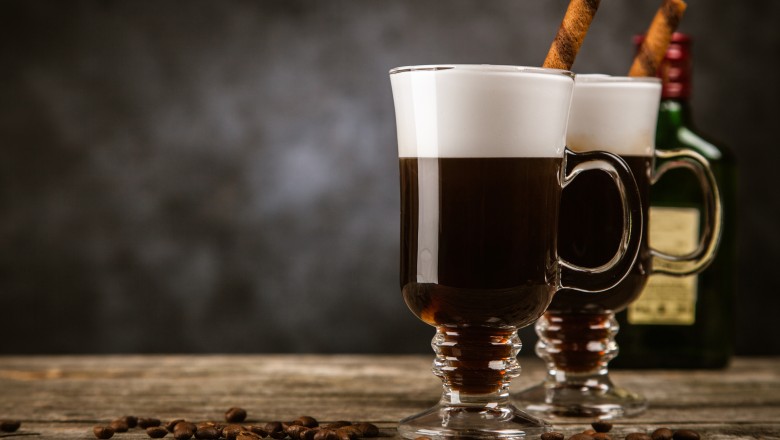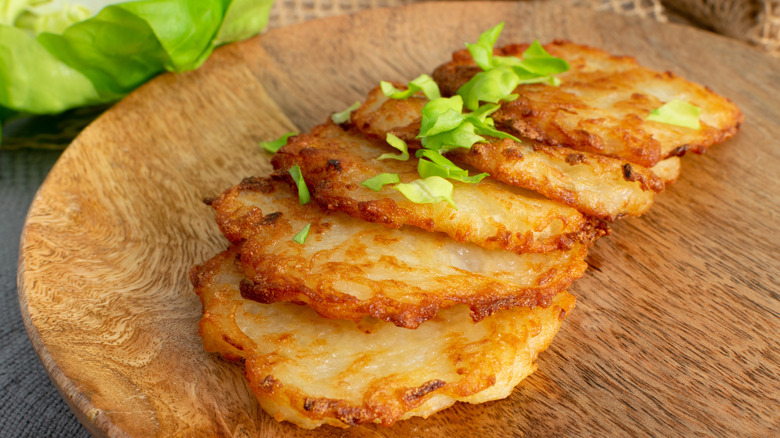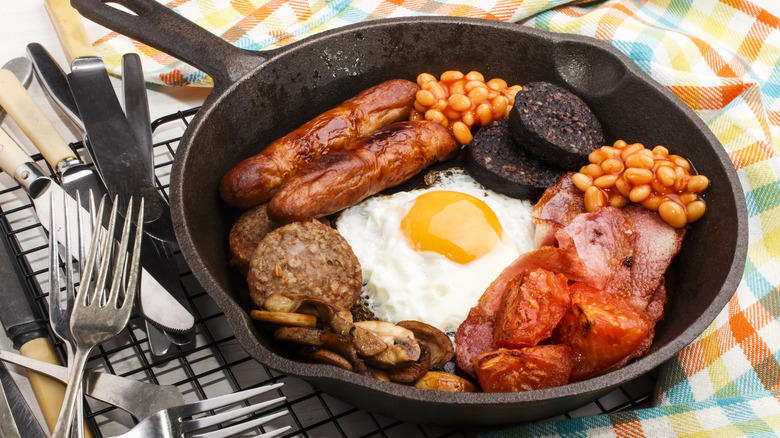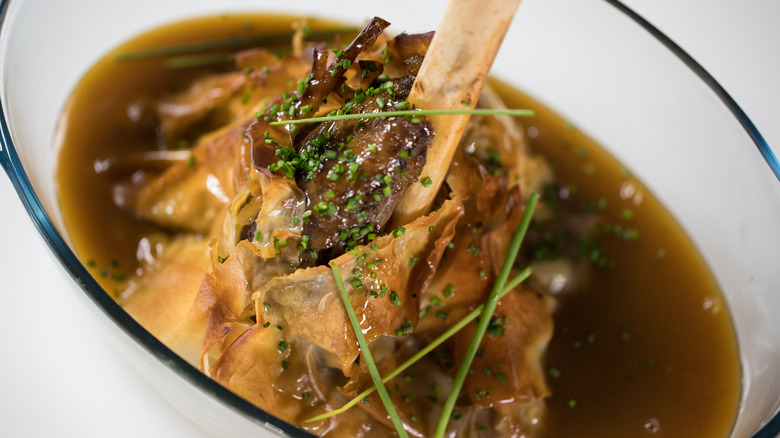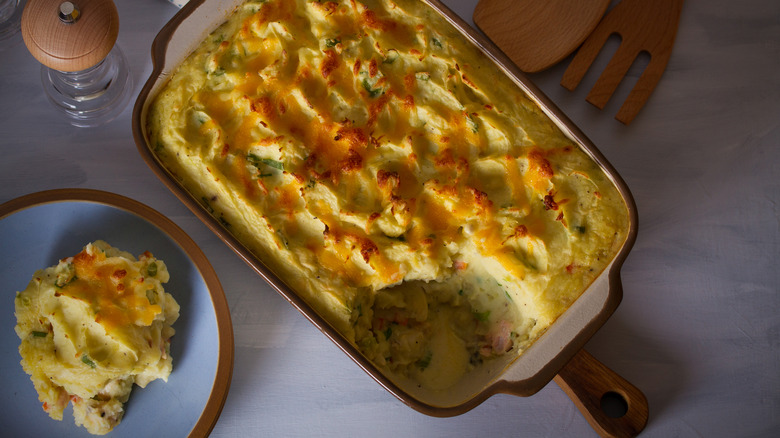What Irish People Really Eat On St. Patrick's Day
It's often said that everyone is at least a little bit Irish on St. Patrick's Day, and across America, it's certainly a giant celebration of green beer and tiny leprechauns. No St. Patrick's Day in America would be complete without a dinner of corned beef and cabbage (probably served at the local pub), but that's not quite as Irish as you think it is. That dish actually comes from the early days of Irish immigrants in America, not the old country itself. Head over to Ireland and you'll certainly find all sorts of parades, festivals, live music, and street carnivals, but you definitely won't find any corned beef on the table — and there won't be any green beer, either (sorry!). An Irish St. Patrick's Day meal revolves around staple ingredients that have remained part of the Irish tradition for generations. It's not what you're probably expecting, but that doesn't mean that it's boring!
Irish bacon
When Americans hear the word "bacon," our thoughts are filled with the idea of crispy strips of pig-sourced goodness. They're the stuff of BLTs and burgers, but head to Ireland and you'll find the number one meat of St. Patrick's day is bacon that's so different, it's worth talking about a bit.
Bacon is loosely defined as meat that's cut from parts of the pig that aren't the legs (that's gammon), and it typically comes from the loin, belly, or collar. When it comes to St. Patrick's Day, almost every restaurant and countless dinner tables in Ireland will be serving up a loin of bacon. For a super-traditional version of this, check out this recipe from the Irish Food Board for Loin of Bacon with Creamy Cabbage and Champ. The loin is boiled based on weight and seasoned with things like peppercorns and mustard. Later, it's glazed with vinegar, honey, more mustard, rosemary, and sage. Cooked cabbage is a staple side dish, and as for champ, that's mashed potatoes with scallions, milk, and butter.
Lamb stew
St. Patrick's Day heralds spring in Ireland, and with the spring comes thousands of baby lambs, popping up in pastures across the country. It might seem a bit of a challenge to imagine eating those adorable, frolicking little creatures, but lamb stew will be on menus across the country.
Donal Skehan, one of Ireland's biggest food writers and presenters, gives us this incredible traditional recipe for lamb stew. Handed down through his family, it calls for things like onions, celery, carrots, a great heaping of potatoes, and in true Irish fashion, a bunch of butter. Hearty and delicious, the lamb stew wasn't just meant to taste good, it was meant to fill up an entire family as efficiently as possible. Skehan says this recipe is rooted in one that kept generations of his family going, and you'll see why. Best of all, this is one recipe you can serve for St. Patrick's Day and keep in the refrigerator on the off-chance there are any leftovers. It'll taste even more amazing the next day, and nothing will go to waste.
Chicken and leek pie
True traditional Irish food is hot and hearty — it's a nation that takes comfort food to a whole new level. If you've never had chicken and leek pie, St. Patrick's Day is a perfect reason to try it ... and you might find it's earned a new place among your favorites for cold winters and rainy springtime evenings.
Prep is easy — it only takes around 40 minutes to put together — but since you're going to have to let this one cook for a couple of hours, be sure to plan ahead. This recipe from Nigel Slater is sure to be a hit, especially with a family that likes savory pies. The filling is a creamy chicken, bacon, and leek mixture that's given a bit of extra kick with a dash of mustard and some peppercorns, while the puff pastry crust means you're cutting through nothing but flaky goodness to get at that hot, tasty center.
Steak and Guinness pie
The Irish love their pies, and a bit of steak and Guinness pie is a guarantee for many traditional tables set for St. Patrick's Day celebrations. There are a lot of different variations of this, and you've probably heard of steak and kidney pie. If the idea of throwing some ox's kidneys into your pie filling makes you cringe, don't fear. There are plenty of versions that don't call for kidneys, although it's a traditional ingredient in recipes geared toward making sure every bit of the animal gets used properly. Still, it might not be up to modern tastes, so let's look at a few kidney-free versions.
Donal Skehan has an amazing version of this, too, that calls for beef shoulder, stock, and Guinness for the filling, with a super easy puff pastry crust. With only a handful of other ingredients in the filling — pepper, bay leaf, carrots, onions, and a bit of garlic — this recipe is phenomenal for the simple reason that you're tasting every bit of the beef and Guinness instead of other flavors that might mask what makes this a long-time favorite in homes across Ireland. If you're a fan of mushrooms, this recipe from BBC Goodfood might be a win for your family. It includes dried porcini mushrooms and goes a little lighter on the beer (calling for ale rather than stout), proving there's really no wrong way to make this favorite.
Shepherd's and cottage pie
You've probably heard of shepherd's pie, and you might even know that in this case, "pie" can be a bit misleading. There's no crust on this one, and instead, this tasty, hearty casserole is made with minced meat, topped with mashed potatoes (or, just "mash" if you're authentically Irish), and baked.
Shepherd's pie and cottage pie are both huge favorites, and they're going to be on every restaurant's menu come St. Patrick's Day. They're staples on every other day of the year, too, and these hearty stews are exactly the type of comfort food that's needed to drive away the blues that come with a long Irish winter. They're made in exactly the same way, with one key difference. To be considered shepherd's pie, the filling needs to be lamb mince.
Cottage pie, on the other hand, is the same idea made with beef mince. For generations, the Irish have found ways to make use of the food they have available, and that makes their traditional foods great for experimentation. Fancy some cheesy garlic mash baked on top of your cottage pie? Go for it. Want to go a bit more simple, with just some butter? That's all right, too.
Colcannon
Cabbage might be the family's least favorite part of St. Patrick's Day dinner, and there are probably a few people you know who give it a miss altogether. If you want to get everyone enjoying their sides, take a page out of the traditional Irish recipe book and try colcannon instead.
Colcannon isn't just for St. Patrick's Day in Ireland, it's a Samhain favorite and it's also on the dinner table for every Sunday roast. If you're looking for something truly traditional, Discover Mayo offers up this traditional colcannon recipe that's similar to what you'll find all over the country. Made with either kale or cabbage, colcannon combines all the deliciousness of buttery mash with some of Ireland's staple vegetables. Also in true Irish fashion, you can make plenty of additions or substitutions to this one, too. Most colcannon calls for a generous dose of heavy cream, but you can also swap that with milk if you prefer. You're also not going to go wrong if you add in some finely chopped bacon pieces — Irish or American — but this is one dish that can definitely stand on its own simplicity.
Soda bread
In many places, bread recipes rely on yeast as the agent that makes them rise. In Ireland, though, that's traditionally been a little difficult to do. Ireland's climate presents some particular problems when it comes to baking, and that includes getting things to rise properly. Wheat flour grown and produced in Ireland is what's known as "soft," and the low protein content of that flour means yeast doesn't work in quite the same way. Favor in the nearly continuous hardships the Irish have faced across the generations, and you'll find you're back at the idea of using what's on hand and what's affordable to survive. The Irish have long relied on bread made not from yeast, but bicarbonate of soda. Also called baking soda, or bread soda, this particular ingredient works to make bread rise when it reacts with other ingredients to produce CO2.
While you might find all kinds of bread at a grocery store or bakery, it's soda bread that still forms the backbone of a traditional meal, and it's always on the table. It's incredibly easy to make and can be either white or brown. The Irish Food Board offers us this recipe for a traditional white soda bread and this one for a brown, and once you make this one for your table, it's going to be a staple in your home, too. Another benefit of this one is its versatility it's just as good first thing in the morning with a bit of butter and honey as it is in the evening, soaking up the last remains of the gravy from a steak and ale pie.
Rhubarb tart
As tempting as it might be to whip up a batch of chocolate cupcakes with green frosting, it's just as easy — and just as tasty — to bake up a dessert that's going to be seen finishing off a traditional St. Patrick's Day meal in Ireland, too. The Irish climate is perfect for growing rhubarb, and that means it's been a staple of sweet dishes for generations.
The Irish Food Board gives us this incredibly easy rhubarb tart, complete with a splash of Irish whiskey in the cream to round out the sweetness. With only seven ingredients — including the cream and the whiskey — it's a fitting end to a lovely meal.
If a pie is more your style, try this recipe from Parade. It's adapted from an old idea that combined rhubarb, sugar, and bread dough in a pot and cooked it over an open fire. It wasn't long ago that many Irish houses still had open fires for heat and cooking, especially in the country. The filling is still simply rhubarb sweetened with sugar, and the dough is heavy on butter, milk, and sugar for a super flaky crust.
Apple cake
If rhubarb isn't your thing — and it's definitely not for everyone — then a traditional apple cake might be more up your alley. If you're looking for something truly Irish, this apple cake might be the perfect thing to have with your after-dinner coffee.
There's no right way to make this one, either, and most families have their own go-to recipe when it comes to making it. It's something that was passed down through the generations, and there are plenty of recipes out there. Try this one from The Guardian for a dessert that's part cake, part tart, a thin slice of apple-filled goodness that's not too heavy to eat after you've filled yourself up with other hearty mains. If you're looking for something a little more substantial, try this version from The Kitchen McCabe, which is a little more like a cake and is topped with something that is quintessentially Irish: custard.
You can also opt to go the tart route, with recipes like this one from Farmette. Part pie and part cake, this light and tasty dessert is just the right amount of sweetness to finish off your St. Patrick's Day celebrations, no matter where in the world you are.
Irish coffee
You'd be remiss if you left the alcohol out of St. Patrick's Day, but in Ireland, you'd be hard-pressed to find a green beer anywhere. While Guinness remains one of the most widespread favorites on St. Patrick's Day — and any day — in Ireland, you might find yourself wanting something a little extra special. You'd be right in line with the old country if you served up some Irish coffee, and unlike green beer, this one actually is authentically Irish.
In the 1930s, Foynes in County Limerick gained a bit of popularity for being a stopping point for those traveling from the States to mainland Europe. In 1942, a flight leaving Foynes for Greenland was forced to turn back because of the weather, and knowing the passengers would be cold and exhausted by the time they got back, the airport restaurant whipped up something extra special for them. Chef Joe Sheridan served up some coffee and gave it an extra kick with a dash of whiskey, a sprinkling of brown sugar, and a dollop of fresh whipped cream. The recipe spread, but most of those that tried to recreate it failed: The cream would sink to the bottom.
Fortunately, it's not a trade secret, and you have all the tools you need to make authentic Irish coffee, no matter where you are. Good Food Ireland gives you all the necessary details, including the trick to getting the cream to float on the top, as it should. It should be only lightly whipped, and pouring it off the back of a spoon onto the surface of the coffee will give it a nice, creamy head, just like you're served on chilly, rainy Irish nights.
Boxty
It may be a bit bold to say that literally every other vegetable pales in comparison to potatoes, but is it really? Because from french fries and wedges to jacket potatoes and mash, potatoes' versatility is unmatched, and if you're Irish, boxty is just another way to revel in the potato's goodness. According to Marca, boxty is a traditional Irish dish that's made using potatoes, flour, and milk. Incorporating both mashed and raw potatoes into the batter, boxty — at times referred to as a potato pancake — can often be found on a breakfast plate. However, it's versatile enough to be served as a lunch dish, like when it's paired with haddock and sauce.
While potatoes are a popular ingredient in Irish cuisine, per Catholic Digest, they arrived so long after Saint Patrick's death that he never got to taste them. Nevertheless, the tuber remains a significant part of Irish history. In 1845, Ireland experienced such a terrible bout of blight on the potato crop that many people died of starvation while others fled to other countries. Over time though, it went from a crop that primarily poor people depended on for their survival to one that is celebrated on the Irish banquet table. Potatoes being such a central part of contemporary Irish cuisine speaks volumes to the extraordinary resilience of the country's people.
Irish fry-up
We all know that breakfast is the most important meal of the day, and on St. Patrick's Day it's especially great to start the festivities with a good old Irish fry-up. Listed among the world's best morning dishes, you may be wondering what an Irish fry-up, or full Irish breakfast, truly means. According to Vice reporter Nell Frizzell, they are so much of a thing to behold that at O'Neill's, a pub chain found around Britain, the Irish fry-up made an honorary appearance on the menu in the form of "The Unfinishable Breakfast."
At the time, this breakfast was said to contain four rashers of bacon, four pork sausages, three fried eggs, grilled tomatoes, mushrooms, and baked beans, all on a giant potato and onion hash brown. But what happens when it arrives and what was simply listed as mushrooms and grilled tomatoes is in fact four mushrooms and four tomato halves, all accompanied by a whopping eight slices of toast? Fortunately, you don't have to go to such extremes to enjoy a fry-up on St. Patrick's Day. A more traditional Irish fry-up would include these components (just less of each) and feature black pudding, Irish soda bread, and plenty of tea.
Spring lamb
Spring lamb is not so much a dish as it is a seasonal meat. Used in a variety of roasts made to personal tastes, per Sysco Ireland, spring lamb tends to be the lamb of choice due to its milder aroma and more milky flavor when compared to lamb cultivated during other seasons. As such, with the season coinciding with St. Patrick's Day, this is a prime opportunity for lamb lovers to indulge.
Additionally, lamb is such a prominent fixture in Irish cuisine that Ireland-born Chef Cathal Armstrong chose to showcase it among a range of other Irish dishes featured in his inaugural cookbook, "My Irish Table" (via Smithsonian Magazine). Armstrong notes that spring lamb is the usual St. Patrick's Day dish to serve in Ireland. He presents his roast lamb with jus. The lamb is roasted with a herb pesto and can be served with seasonal vegetables like carrots, asparagus, and peas.
Irish Fish Pie
If you thought Irish people would be all pied out after all the chicken and leek pie, steak and Guinness pie, and shepherd's and cottage pies, think again. One cannot speak of the array of pies served and enjoyed on St. Patrick's Day without mentioning Irish fish pie. As Irish chef Clodagh McKenna noted during a segment of "This Morning," "fish is very traditional in Ireland because we are an island," hence she created the Ultimate Fish Pie with Potato Rosti.
To make it, mixed fish are poached in milk, which is then simmered with a roux to make a creamy bechamel sauce. The fish is then transferred to a casserole dish before the bechamel sauce is poured over it. In a separate bowl, grated raw potatoes are mixed with cheddar and herbs and sprinkled over the casserole. Do note that this dish is not the ultimate unless several prawns are placed along the side and baked with the pie to infuse even more flavor.

